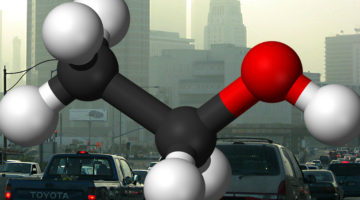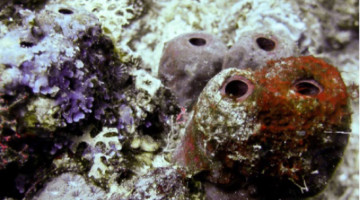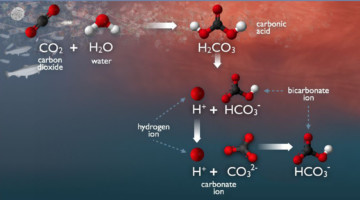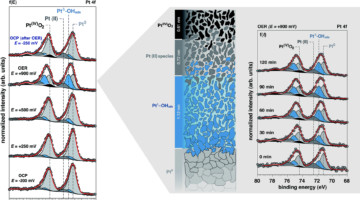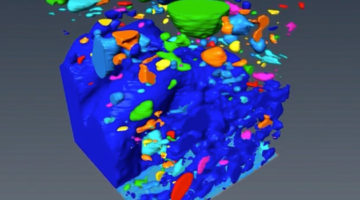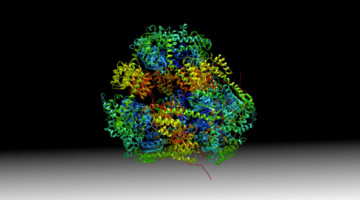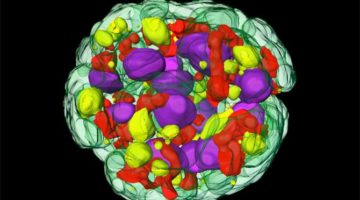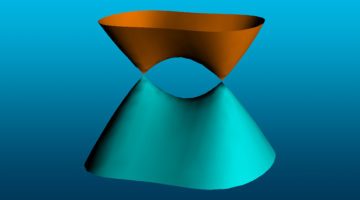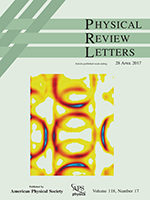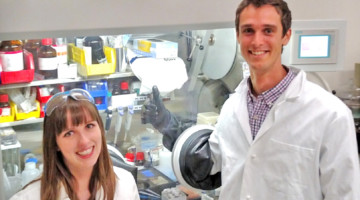X-ray experiments, coupled with theoretical work, revealed how oxygen atoms embedded near the surface of a copper sample had a more dramatic effect on the early stages of a reaction with CO2 than accounted for in earlier theories. This work could prove useful in designing new catalysts for converting CO2 into liquid fuels and other products. Read more »
Bacterial Symbiont Sequesters Arsenic and Barium in Sponges
Researchers used x-ray fluorescence, spectroscopy, and diffraction to study how populations of symbiotic bacteria can act as a detox organ in a host with no organs. The bacteria, members of the species Entotheonella, accumulate and mineralize large quantities of arsenic and barium in sponges. Read more »
APXPS Finds Carbonate Reversal at Liquid Interfaces
Aqueous carbonate systems are central to many processes essential to life, from the blood buffer system to the global carbon cycle. Using APXPS, researchers probed the concentration of carbonates near an interface, finding a surprising reversal in the expected abundances as a function of depth. Read more »![]()
![]()
A Closer Look at a Working Platinum/Electrolyte Interface
Ambient-pressure studies of the interface between a platinum electrode and an alkaline electrolyte revealed the molecular-level chemistry, structure, and dynamics of the platinum surface as a function of applied potential, highlighting differences between thermodynamic predictions and the actual surface composition. Read more »
How X-rays Helped to Solve Mystery of Floating Rocks
Some rocks can float on water for years at a time before eventually sinking. X-ray microtomography studies help explain how by scanning samples of lightweight, glassy, and porous volcanic rocks known as pumice stones. Their surprisingly long-lived buoyancy can help scientists discover underwater volcano eruptions. Read more »
A Hollow Pyramid Unlocks Principles of Protein Architecture
Researchers have designed a hollow, pyramid-shaped protein with a controllable cavity size that could be useful in the capture and release of smaller compounds. The tools and techniques developed could be useful in analyzing and optimizing designed protein assemblies and understanding their behavior in solution. Read more »
Sequencing of Green Alga Genome Provides Blueprint to Advance Clean Energy, Bioproducts
Scientists have sequenced the genome of a green alga that has drawn commercial interest as a strong producer of quality lipids for biofuel production. The chromosome-assembly genome of Chromochloris zofingiensis provides a blueprint for new discoveries in sustainable biofuels, antioxidants, and other valuable bioproducts. Read more »
Strain Turns Tin into a 3D Topological Dirac Semimetal
A small amount of compressive strain turns a nonmetallic form of tin into a 3D topological Dirac semimetal—a kind of “supermetal” with very high electron mobility. With its rich topological phase diagram, the material shows promise for both novel physics and eventual device applications. Read more »![]()
![]()
Electronic Phase Separation and Dramatic Inverse Band Renormalization in the Mixed-Valence Cuprate LiCu2O2
Angle-resolved photoemission spectroscopy was used to measure the electronic structure of LiCu2O2, a mixed-valence cuprate where planes of Cu(I) (3d10) ions are sandwiched between layers containing one-dimensional edge-sharing Cu(II) (3d9) chains. Read more »
Modulating Infrared Light with 2D Black Phosphorus
Two-dimensional materials represent a promising new frontier in the field of optoelectronics. Most progress so far, however, has been in the visible-light range. Now, at the ALS, researchers have measured the infrared transmission spectra of ultrathin samples of black phosphorus under an applied electric field. Read more »![]()
![]()
- « Previous Page
- 1
- …
- 67
- 68
- 69
- 70
- 71
- …
- 83
- Next Page »
